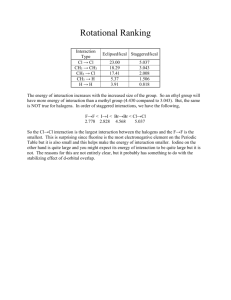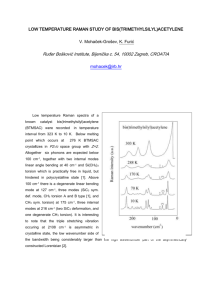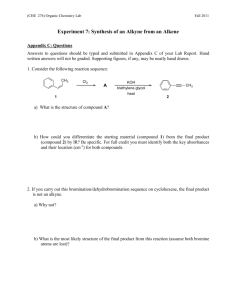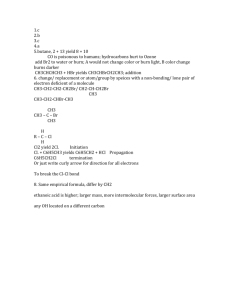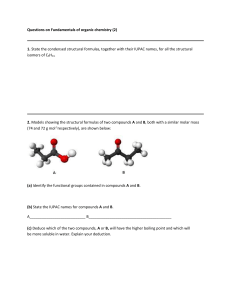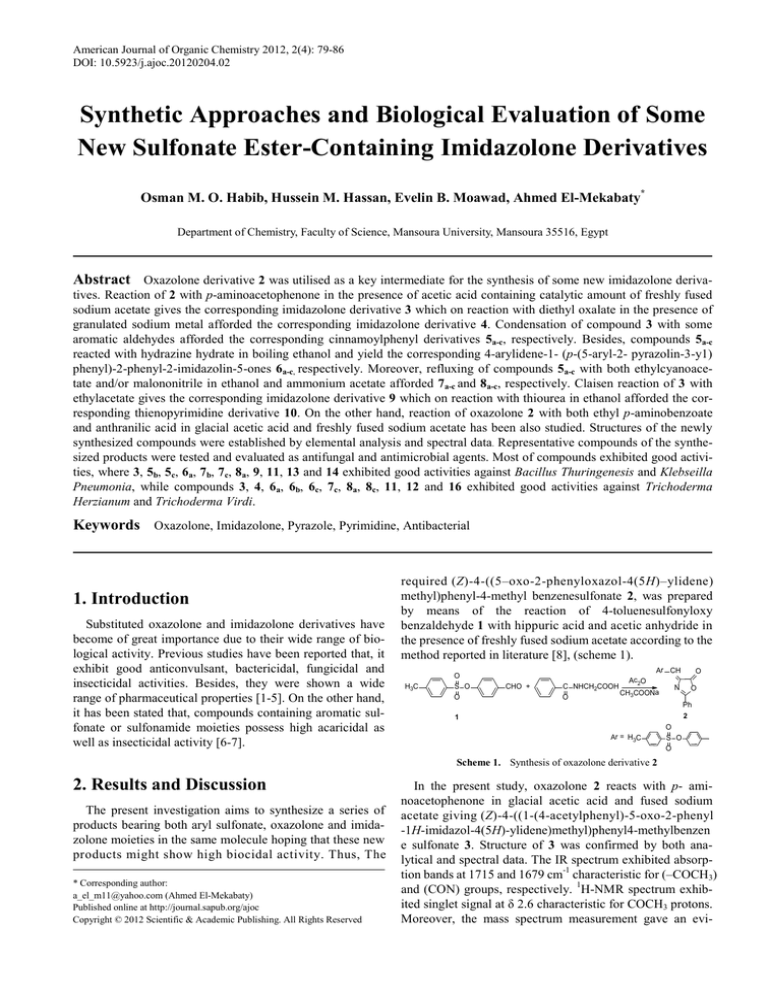
American Journal of Organic Chemistry 2012, 2(4): 79-86
DOI: 10.5923/j.ajoc.20120204.02
Synthetic Approaches and Biological Evaluation of Some
New Sulfonate Ester-Containing Imidazolone Derivatives
Osman M. O. Habib, Hussein M. Hassan, Evelin B. Moawad, Ahmed El-Mekabaty*
Department of Chemistry, Faculty of Science, Mansoura University, Mansoura 35516, Egypt
Abstract Oxazolone derivative 2 was utilised as a key intermediate for the synthesis of some new imidazolone deriva-
tives. Reaction of 2 with p-aminoacetophenone in the presence of acetic acid containing catalytic amount of freshly fused
sodium acetate gives the corresponding imidazolone derivative 3 which on reaction with diethyl oxalate in the presence of
granulated sodium metal afforded the corresponding imidazolone derivative 4. Condensation of compound 3 with some
aromatic aldehydes afforded the corresponding cinnamoylphenyl derivatives 5a-c, respectively. Besides, compounds 5a-c
reacted with hydrazine hydrate in boiling ethanol and yield the corresponding 4-arylidene-1- (p-(5-aryl-2- pyrazolin-3-y1)
phenyl)-2-phenyl-2-imidazolin-5-ones 6a-c, respectively. Moreover, refluxing of compounds 5a-c with both ethylcyanoacetate and/or malononitrile in ethanol and ammonium acetate afforded 7a-c and 8a-c, respectively. Claisen reaction of 3 with
ethylacetate gives the corresponding imidazolone derivative 9 which on reaction with thiourea in ethanol afforded the corresponding thienopyrimidine derivative 10. On the other hand, reaction of oxazolone 2 with both ethyl p-aminobenzoate
and anthranilic acid in glacial acetic acid and freshly fused sodium acetate has been also studied. Structures of the newly
synthesized compounds were established by elemental analysis and spectral data. Representative compounds of the synthesized products were tested and evaluated as antifungal and antimicrobial agents. Most of compounds exhibited good activities, where 3, 5b, 5c, 6a, 7b, 7c, 8a, 9, 11, 13 and 14 exhibited good activities against Bacillus Thuringenesis and Klebseilla
Pneumonia, while compounds 3, 4, 6a, 6b, 6c, 7c, 8a, 8c, 11, 12 and 16 exhibited good activities against Trichoderma
Herzianum and Trichoderma Virdi.
Keywords Oxazolone, Imidazolone, Pyrazole, Pyrimidine, Antibacterial
1. Introduction
Substituted oxazolone and imidazolone derivatives have
become of great importance due to their wide range of biological activity. Previous studies have been reported that, it
exhibit good anticonvulsant, bactericidal, fungicidal and
insecticidal activities. Besides, they were shown a wide
range of pharmaceutical properties [1-5]. On the other hand,
it has been stated that, compounds containing aromatic sulfonate or sulfonamide moieties possess high acaricidal as
well as insecticidal activity [6-7].
required (Z)-4-((5–oxo-2-phenyloxazol-4(5H)–ylidene)
methyl)phenyl-4-methyl benzenesulfonate 2, was prepared
by means of the reaction of 4-toluenesulfonyloxy
benzaldehyde 1 with hippuric acid and acetic anhydride in
the presence of freshly fused sodium acetate according to the
method reported in literature [8], (scheme 1).
H3C
O
S O
O
Ar CH
CHO +
Ac2O
C NHCH2COOH
CH3COONa
O
O
N
O
Ph
2
1
Ar = H3C
O
S O
O
Scheme 1. Synthesis of oxazolone derivative 2
2. Results and Discussion
The present investigation aims to synthesize a series of
products bearing both aryl sulfonate, oxazolone and imidazolone moieties in the same molecule hoping that these new
products might show high biocidal activity. Thus, The
* Corresponding author:
a_el_m11@yahoo.com (Ahmed El-Mekabaty)
Published online at http://journal.sapub.org/ajoc
Copyright © 2012 Scientific & Academic Publishing. All Rights Reserved
In the present study, oxazolone 2 reacts with p- aminoacetophenone in glacial acetic acid and fused sodium
acetate giving (Z)-4-((1-(4-acetylphenyl)-5-oxo-2-phenyl
-1H-imidazol-4(5H)-ylidene)methyl)phenyl4-methylbenzen
e sulfonate 3. Structure of 3 was confirmed by both analytical and spectral data. The IR spectrum exhibited absorption bands at 1715 and 1679 cm-1 characteristic for (–COCH3)
and (CON) groups, respectively. 1H-NMR spectrum exhibited singlet signal at δ 2.6 characteristic for COCH3 protons.
Moreover, the mass spectrum measurement gave an evi-
Osman M. O. Habib et al.: Synthetic Approaches and Biological Evaluation of
Some New Sulfonate Ester-Containing Imidazolone Derivatives
dence for the proposed structure, which showed the molecular ion peak at m/e 536 (M+) (Scheme 2).
H
Ar C
O
N
O
Ph
2
AcOH H2N
Ar CH
O
N
N
O
C CH3
O
C CH3
Ph
H
Ar C
Diethyloxalate
Na- metal
O
O H O
2
C C C COOEt
N
Ph
4
R
3
N
Ar CH
CHO
N
alc. KOH
O
O
C C C Ar'
H H
N
Ph
Ar = H3C
Scheme 2.
O
S O
O
5a, Ar' = C6H55b, Ar' = 4-OCH3C6H45c, Ar' = 4-CH3C6H4-
Reaction of oxazolone 2 with p-aminoacetophenone
Treatment of compound 3 with diethyl oxalate in the
presence of granulated sodium metal produced the corresponding imidazolone derivative 4. In addition, compound 3
undergoes condensation with some aromatic aldehydes
namely, benzaldehyde; p-anisaldehyde and p-tolualdehyde
to give the corresponding cinnamoylphenyl derivatives 5a-c,
respectively (scheme 2). Chemical structures of compounds
5a-c were established on both elemental and spectral evidences. So, the IR spectrum in general showed stretching
frequencies at 1675 and 1645 cm-1 attributable to the CON
and C=O (Chalcone) groups. 1H-NMR spectra of compound
5b showed multiple signals at about δ 8.2-8.3 corresponding
to olefinic CH=CH protons and singlet signal at δ 4.4 for the
OCH3 protons. Besides, compound 5c revealed multiple
signals at about δ 8.2-8.3 corresponding to olefinic CH=CH
protons and singlet signal at δ 2.1 for the -CH3 protons.
Moreover, structures 5a-c were confirmed by the mass spectral measurements which showed the molecular ion peaks at
m/e 624 (M+), m/e 654 (M+) and m/e 638 (M+), respectively.
Besides, compounds 5a-c reacted with hydrazine hydrate in
boiling ethanol to give the corresponding 4-arylidene-1(p-(5-aryl-2-pyrazolin-3-y1)phenyl)-2-phenyl-2-imidazolin5-ones 6a-c, respectively. Structures 6a-c were established on
both elemental and spectral evidences. So, 1H-NMR spectrum in general showed revealed doublet signals at δ 3.1
corresponding for CH2 protons of pyrazole. The IR spectra of
these compounds showed characteristic absorption bands at
3200-3260 cm-1 attributable to (-NH) group. In addition,
structures 6a-c were confirmed by the mass spectrophotometric measurements which showed the molecular ion
peaks at m/e 638 (M+), m/e 668 (M+) and m/e 652 (M+),
respectively. Moreover, refluxing of compounds 5a-c with
both ethylcyanoacetate and/or malononitrile in ethanol and
excess of ammonium acetate afforded 7a-c and 8a-c, respectively (scheme 3).
On the other hand, treatment of imidazolone 3 with ethylacetate in the presence of sodium metal gives the corresponding 1,3-diketone derivative 9 which reacted with
thiourea in ethanol giving the thiopyrimidine derivative 10.
The structure of compound 10 was elucidated on the basis of
both analytical and spectral data. The IR spectrum of compound 10 displayed absorption band at 1370 cm-1 due to
(C=S) group. In addition, the mass spectrum gives a molecular ion peak at m/e 621 (M++2) (scheme 4).
H
Ar C
NH2-NH2
O
Ar'
N
N
Ethanol
N NH
Ph
6a, Ar' = C6H56b, Ar' = 4-OCH3C6H46c, Ar' = 4-CH3C6H4-
Ar CH
O
N
N
Ph
O
C C C Ar'
H H
H
Ar C
NCCH2COOEt
Ethanol
O
CN
NH
O
Ph
7a, Ar' = C6H57b, Ar' = 4-OCH3C6H47c, Ar' = 4-CH3C6H4Ar CH
O
SO
O
Ar'
N
N
5a, Ar' = C6H55b, Ar' = 4-OCH3C6H45c, Ar' = 4-CH3C6H4-
Ar = H3C
80
NCCH2CN N
Ethanol
O
N
Ph
Ar'
CN
NH
NH
8a, Ar' = C6H58b, Ar' = 4-OCH3C6H48c, Ar' = 4-CH3C6H4-
Scheme 3. Reaction of imidazolone derivatives 5a-c with hydrazine hydrate, ethylcyanoacetate and malononitrlie
81
American Journal of Organic Chemistry 2012, 2(4): 79-86
Oxazolone 2 reacted with ethyl p-aminobenzoate in glacial acetic acid and freshly fused sodium acetate to give
(Z)-ethyl 4-(5-oxo-2-phenyl-4-(4-(tosyloxy)benzylidene)-4,
5-dihydro-1H-imidazol-1-yl) benzoate 11. The IR spectrum
of 11 showed absorption bands at 1680 and 1725 cm-1 due to
(CON) and carbonyl ester groups. 1H-NMR showed signals
at δ 4.39-4.42 (q, 2H, -CH2CH3) and δ 1.39-1.43 (t, 3H,
-CH2CH3). The mass spectrum of compound 11 showed the
molecular ion peak at m/e 566 (M+). Tratment of imidazolone 11 with benzylamine in ethanol afforded (Z)-4-((1-(4(benzylcar bamoyl)phenyl)-5-oxo-2-phenyl-1H-imidazol-4(
5H)-ylidene)methyl)phenyl4-methylbenzenesulfonate 12,
(scheme 5). The structure of compound 12 was established
on both analytical and spectral data. The IR spectrum exhibited bands at 1690 and 3478 cm-1 corresponding to -CON
and -NH groups and revealed the absence of a carbonyl of
ester group absorption band. 1H-NMR spectrum revealed
singlet signals at δ 4.2 and δ 11 characteristic for -CH2Ph.
The mass spectrum revealed molecular ion peak at m/e 626.6
(M+-1) with relative abundance corresponding to the molecular formula C37H29N3O5S.
H
Ar C
O
Ar CH
O
Ethyl acetate
C CH3
N
Na-metal
N
N
Ph
O
N
Ph
3
O
S O
O
N
O
O
H2N
Ar CH
N
N
COOEt
Ph
11
NH2NH2
EtOH
Ar = H3C
Ar = H3C
N
N
N
CONHNH2
15
H
Ar C
O
N
N
CONHNH2
Scheme 6. Reaction of imidazolone derivative 11 with hydrazine hydrate
CH3
N
N
S
Ar CH
Ar CH O
C NH-NH2
NH2-NH2
COOEt
N
N
-H , + H
Ph H
O
N
N
Ph
COOEt
11
-H , + H
COOEt
O
H
Ar C
COOEt +
H2N
NH
NH
N
Ph
14
O
N
NHNH2
Ph
1500C PhCH2NH2
O
S O
O
Ph
14
H
Ar C
N
O
S O
O
Ph
11
H
Ar C
NH
NH
N
O
N
AcOH
O
O
N
10
Ph
2
13
H
Ar C
16
Ph
COOEt
COOEt
Ph
O
Ar CH
N
Ph
Scheme 4. Reaction of imidazolone derivative 3 with ethyl acetate
Ar CH
NNH2
N
9
Ar CH
Ar = H3C
Ar CH
O H O
2
C C C CH3
Ethanol Thiourea
N
on the basis of both analytical and spectral data. The IR
spectrum showed absorption bands at 3470, 1760 and 1595
cm-1 due to amidic (NH), carbonyl of lactone and (C=C)
groups. 1H-NMR spectrum revealed singlet signals at δ 4.9
characteristic for CH=C protons. Moreover, the mass spectrum showed the molecular ion peak at m/e 538 (M+). Formation of compound 17 could proceed via the plausible
mechanism (scheme 9).
CONHCH2Ph
Scheme 7.
The plausible mechanism for the formation of compound 14
O
Ph
12
AcOH
O
Scheme 5. Condensation of oxazolone 2 with ethyl p-aminobenzoate
Furthermore, the reaction of imidazolone 11 with hydrazine hydrate is interesting since refluxing in ethanol gives
four products 13-16 which were isolated by using column
chromatography (scheme 6). Formation of compound 14
could proceed via the plausible mechanism, (scheme 7).
On the other hand, refluxing of oxazolone 2 with anthranilic acid in glacial acetic acid and fused sodium acetate
gives the benzoxazinone derivative 17 instead of compound
17' (scheme 8). The structure of compound 17 was elucidated
N
Ar CH
N
O
O
Ph
2
Ar = H3C
HOOC
+
H2N
17
Ar CH
N
O
S O
O
C CH-Ar
NHCOPh
O COOH
N
Ph
17'
Scheme 8. Condensation of oxazolone 2 with anthranilic acid
Osman M. O. Habib et al.: Synthetic Approaches and Biological Evaluation of
Some New Sulfonate Ester-Containing Imidazolone Derivatives
Ar CH
O
N
O
Ph
H2N
+
HOOC
Ar CH O H
C N
N
OH
HOOC
Ph
activity against Bacillus Thuringenesis, Klebseilla Pneumonia, Trichoderma Herzianum and Trichoderma Virdi.
H
Ar C
All melting points (uncorrected) were determined on
Gallenkamp electric melting point apparatus, FTIR spectra
(KBr disk) were recorded on a Nicolet Magna. IR model 550
spectrophotometers, 1H-NMR spectra, were determined on
Brucker Wpsy 300 MHZ spectrometer with TMS as internal
standard and the chemical shifts are in σ ppm. Mass spectra
were recorded at 70 ev with a Varian MAT 311. Elemental
analyses are satisfactory for all synthesized compounds
(2-17), all analyses were carried out in Faculty of Science,
Cairo University, Egypt. (Z)-4-((5–oxo-2-phenyloxazol4(5H)–ylidene)methyl)phenyl-4-methylbenzene sulfonate 2
was prepared previously as shown in literature [8].
Synthesis of (Z)-4-((1-(4-acetylphenyl)-5-oxo-2-phenyl
-1H-imidazol-4(5H)-ylidene)methyl)phenyl-4-methyl
benzenesulfonate (3).
A mixture of oxazolone 2 (0.01mole) and p-amino acetophenone (0.01mole) in glacial acetic acid (30 ml) containing freshly fused sodium acetate (0.5gm) was heated
under reflux for 8 hours. The reaction mixture was concentreated under reduced pressure and the separated solid
product was filtered off, and recrystallized from acetic acid
to give 3.
Yellow crystals; Yield 45%; m.p. 180-182oC; IR (KBr):
ν/cm-1: 1715 (COCH3), 1679 (CO, amidic), 1645 (C=N),
1360 (SO3); EIMS (m/z) (%): 536 (M+, 21.7), 419 (2.1), 380
(25.4), 278 (9.8), 222 (86), 155 (13), 117 (32), 91 (100), 65
(47.7); 1H NMR (DMSO) (δ, ppm), 2.4 (s, 3H, CH3), 2.6 (s,
3H, COCH3), 7.1-8.2 (m, 18H, Ar-H, CH=C); Anal. for
C31H24N2O5S (536.6): Calcd.: C, 69.39; H, 4.51; N, 5.22℅;
Found: C, 69.33; H, 4.49; N, 5.19℅.
2
NHCOPh
Ar C C
N
H
O
-H2O
82
PhOCHN
O
17
C N
OH
HO C O
Scheme 9. The plausible mechanism for the formation of compound 17
3. Antimicrobial Activity
All the compounds were subjected to biological screening
and they showed promising antibacterial and antifungal
activity which were comparable to the activity of known
standard drugs. The results are summarized in Table (1, 2).
The results for antibacterial activities depicted in Table 1
revealed that, most compounds exhibited good activities
against the reference chemotherapeutics, where 3, 5b, 5c, 6a,
7b, 7c, 8a, 9, 11, 13 and 14 exhibited good activities against
Bacillus Thuringenesis and compounds 3, 5a, 5c, 6a, 7b, 8a,
10, 13, 14, 15 and 16 exhibited good activities against
Klebseilla Pneumonia. On the other hand, the results for
antifungal activities depicted in Table 2 revealed that,
compounds 3, 4, 6a, 6b, 6c, 7c, 8a, 8c, 11, 12 and 16 exhibited good activities against the Trichoderma Herzianum and
Trichoderma Virdi. Therefore, the obtained results indicated
that, the antimicrobial activity is dependent on the attached
groups with oxazolone and imidazolone derivatives. A
comparison of antibacterial and antifungal activities of
compounds with their structures revealed that, the compounds that bearing aryl sulfonate, oxazolone and imidazolone moieties in the same molecule exhibited significant
4. Experimental
Table 1. Diameter of inhibited zones (I. Z. D.) in millimeters as a criterion of antibacterial activity of the synthesized compounds at a concentration of 10
mg/ml
Bacteria
Bacteria
Bacillus Thuringenesis
Klebseilla Pneumonia
I. Z.D. mm
I. Z.D. mm
Bacillus Thuringenesis
Klebseilla Pneumonia
I. Z.D. mm
2
27
33
I. Z.D. mm
8c
28
3
30
28
36
9
31
4
21
29
30
10
18
38
5a
29
44
11
30
33
5b
32
33
12
29
28
5c
35
45
13
31
36
Comp No.
Comp No.
6a
39
50
14
41
41
6b
24
29
15
26
39
6c
29
34
16
24
44
7a
19
28
17
31
31
7b
32
35
Flummox
24
29
7c
35
26
Ampicillin
29
34
8a
39
45
Chloramphenicol
19
28
8b
24
29
-
-
-
83
American Journal of Organic Chemistry 2012, 2(4): 79-86
Table 2.
mg/ml
Diameter of inhibited zones (I. Z. D.) in millimeters as a criterion of antifungal activity of the synthesized compounds at a concentration of 10
Comp No.
2
3
4
5a
5b
5c
6a
6b
6c
7a
7b
7c
8a
8b
Fungi
Trichoderma Herzianum
Trichoderma Virdi
I. Z.D. mm
I. Z.D. mm
31
41
35
46
40
41
41
36
38
33
37
26
44
39
49
36
46
49
29
44
31
48
48
26
46
39
40
36
Comp No.
8c
9
10
11
12
13
14
15
16
17
Flummox
Ampicillin
Chloramphenicol
-
Synthesis of (Z)-ethyl2,4-dioxo-4-(4-(5-oxo-2-phenyl-4(4-(tosyloxy)benzylidene)-4,5-dihydro-1H-imidazol-1-yl)
phenyl)butanoate (4).
A mixture of 3 (0.05mole), dry diethyloxalate (1.15mole)
and granulated sodium metals (0.1mole) were heated at
150ºC for 7 hours. The mixture was triturated with ethanol,
acidified with dil. HCl and the separated solid was recrystallized from ethanol to give 4.
Brown powder; Yield 25%; m.p. 250-252oC; IR (KBr):
ν/cm-1: 1750 (CO, ester), 1720 (CO), 1670 (CO, amidic),
1640 (C=N) and 1360 (SO3); EIMS (m/z) (%): 636 (M+, 27),
375 (54), 272 (45), 261 (31), 233 (21), 118 (100), 70 (68); 1H
NMR (DMSO) (δ, ppm), 2.4 (s, 3H, CH3), 3.71-3.74 (q, 2H,
CH2), 1.25-1.27 (t, 3H, CH3), 4.7 (s, 2H, CH2), 7.1-8.2 (m,
18H, Ar-H, CH=C); Anal. for C35H28N2O8S (636.6): Calcd.:
C, 66.03; H, 4.43; N, 4.4%; Found: C, 66.0; H, 4.40; N,
4.2%.
Synthesis of 4-((1Z)-(5-oxo-2-phenyl-1-(4-(3- arylacryloyl)phenyl)-1H-imidazol-4(5H)-ylidene)methyl)phenyl
4-methylbenzenesulfonate (5a-c).
General procedure
A mixture of 3 (0.01mole) and an appropriate aldehydes
(0.01mole) in ethanolic KOH was refluxed for 8-11 hours.
The solids that separated on acidification with dil. HCl were
filtered and recrystallized from acetone to give 5a-c.
4-((1Z)-(5-oxo-2-phenyl-1-(4-(3-phenylacryloyl)phenyl)1H-imidazol-4(5H)-ylidene)methyl)phenyl-4-methylbenz
enesulfonate 5a:
Yellow sheets; Yield 33%; m.p. 211-213oC; IR (KBr):
ν/cm-1: 1675 (CO, amidic), 1645 (CO, chalcone), 1610
(C=N), 1360 (SO3), 1599 (C=C); EIMS (m/z) (%): 624 (M+,
34), 503 (71), 328 (18), 266 (10), 183 (100), 112 (80), 70
(50); 1H NMR (DMSO) (δ, ppm), 2.4 (s, 3H, CH3), 8.26-8.36
(m, 2H, CH=CH), 7.1-8.1 (m, 23H, Ar-H, CH=C); Anal. for
C38H28N2O5S (624.7): Calcd.: C, 73.06; H, 4.52; N, 4.48%;
Found: C, 72.98; H, 4.49; N, 4.46%.
4-((1Z)-(1-(4-(3-(4-methoxyphenyl)acryloyl)phenyl)-5-ox
o-2-phenyl-1H-imidazol-4(5H)-ylidene)methyl)phenyl-4-
Fungi
Trichoderma Herzianum
I. Z.D. mm
35
41
37
44
49
46
39
24
29
19
35
41
32
-
Trichoderma Virdi
I. Z.D. mm
45
32
38
36
40
47
40
39
45
38
41
36
31
-
methylbenzenesulfonate 5b:
Yellow sheets; Yield 45%; m.p. 177-179oC; IR (KBr):
ν/cm-1: 1675 (CO, amidic), 1645 (CO, chalcone), 1610
(C=N), 1360 (SO3), 1599 (C=C); EIMS (m/z) (%): 654 (M+,
13), 566 (55), 460 (13), 312 (21), 108 (33), 91 (100), 65 (18);
1
H NMR (DMSO) (δ, ppm), 2.4 (s, 3H, CH3), 4.4 (s, 3H,
OCH3), 8.26-8.36 (m, 2H, CH=CH), 7.1-8.1 (m, 23H, Ar-H,
CH=C); Anal. for C39H30N2O6S (654.7): Calcd.: C, 71.54; H,
4.62 , N, 4.27%; Found: C, 71.49; H, 4.59, N, 4.21%.
4-((1Z)-(5-oxo-2-phenyl-1-(4-(3-(p-tolyl)acryloyl)phenyl)
-1H-imidazol-4(5H)-ylidene)methyl)phenyl-4-methyl
benzenesulfonate 5c:
Yellow sheets; Yield 30%; m.p. 154-156oC; IR (KBr):
ν/cm-1: 1675 (CO, amidic), 1645 (CO, chalcone), 1610
(C=N), 1360 (SO3), 1599 (C=C); EIMS (m/z) (%): 638 (M+,
8.3), 480 (61), 348 (100), 220 (31), 160 (54), 90 (30), 70 (61);
1
H NMR (DMSO) (δ, ppm), 2.4 (s, 3H, CH3), 2.1 (s, 3H,
CH3), 8.26-8.36 (m, 2H, CH=CH), 7.1-8.1 (m, 23H, Ar-H,
CH=C); Anal. for C39H30N2O5S (638.7): Calcd.: C, 73.34; H,
4.73; N, 4.38%; Found: C, 73.28; H, 4.69; N, 4.28%.
Synthesis of (Z)-4-((5-oxo-2-phenyl-1-(4-(5-aryl-4,5dihdro-1H-pyrazol-3-yl)phenyl)-1H-imidazol-4(5H)-ylid
ene)methyl)phenyl-4-methylbenzene sulfonate (6a-c).
General procedure
A mixture of the chalcones 5a-c (0.002mole) and hydrazine
hydrate (0.004mole) in ethanol (20 ml) was refluxed for 6
hours. The solid that separated out was recrystallized from
ethanol to give 6a-c.
(Z)-4-((5-oxo-2-phenyl-1-(4-(5-phenyl-4,5-dihydro-1H-p
yrazol-3-yl)phenyl)-1H-imidazol-4 (5H)-ylidene) methyl)
phenyl-4-methylbenzenesulfonate 6a:
Yellow crystals; Yield 43%; m.p. 265-267oC; IR (KBr):
ν/cm-1: 1670 (CO, amidic), 3200-3260 (NH), 1360 (SO3),
1600 (C=N); EIMS (m/z) (%): 638 (M+, 32), 576 (44), 480
(54), 340 (100), 213 (23), 81 (15), 65 (34); 1H NMR (DMSO)
(δ, ppm), 2.4 (s, 3H, CH3), 3.1 (d, 2H, CH2), 8.15 (t, 1H, CH),
9.5 (s, 1H, -NH), 7.1-8.2 (m, 23H, Ar-H, CH=C); Anal. for
C38H30N4O4S (638.7): Calcd.: C, 71.45; H, 4.73; N, 8.77%;
Osman M. O. Habib et al.: Synthetic Approaches and Biological Evaluation of
Some New Sulfonate Ester-Containing Imidazolone Derivatives
Found: C, 71.42; H, 4.69; N, 8.72%.
(Z)-4-((1-(4-(5-(4-methoxyphenyl)-4,5-dihydro-1H-pyraz
ol-3-yl)phenyl)-5-oxo-2-phenyl-1H-imidazol-4(5H)-ylide
ne)methyl)phenyl-4-methylbenzenesulfonate 6b:
Yellow crystals; Yield 55%; m.p. 210-212oC; IR (KBr):
ν/cm-1: 1670 (CO, amidic), 3200-3260 (NH), 1360 (SO3),
1600 (C=N); EIMS (m/z) (%): 668 (M+, 25), 586 (19), 430
(45), 280 (100), 158 (18), 91 (27), 65 (37); 1H NMR (DMSO)
(δ, ppm), 2.4 (s, 3H, CH3), 3.9 (s, 3H, OCH3), 3.1 (d, 2H,
CH2), 8.15 (t, 1H, CH), 9.5 (s, 1H, -NH), 7.1-8.2 (m, 23H,
Ar-H, CH=C); Anal. for C39H32N4O5S (668.7): Calcd.: C,
70.04; H, 4.82; N, 8.37%; Found: C, 70.0; H, 4.79; N, 8.38%.
(Z)-4-((5-oxo-2-phenyl-1-(4-(5-(p-tolyl)-4,5-dihydro-1Hpyrazol-3-yl)phenyl)-1H-imidazol-4-(5H)-ylidene)
methyl)phenyl-4-methylbenzenesulfonate 6c:
Yellow crystals; Yield 41%; m.p. 180-182oC; IR (KBr):
ν/cm-1: 1670 (CO, amidic), 3200-3260 (NH), 1360 (SO3),
1600 (C=N); EIMS (m/z) (%): 652 (M+, 31), 550 (45), 480
(43), 323 (100), 148 (73), 91 (49), 65 (28); 1H NMR (DMSO)
(δ, ppm), 2.4 (s, 3H, CH3), 2.1 (s, 3H, CH3), 3.1 (d, 2H, CH2),
8.15 (t, 1H, CH), 9.5 (s, 1H, -NH), 7.1-8.2 (m, 23H, Ar-H,
CH=C); Anal. for C39H32N4O4S (652.7): Calcd.: C, 71.76; H,
4.94; N, 8.57%; Found: C, 71.71; H, 4.90; N, 8.51%.
Synthesis
of
(Z)-4-((1-(4-(5-cyano-6-oxo-4-aryl1,6-dihydropyridin-3-yl)phenyl)-5-oxo-2-phenyl-1H-imidazol-4(5H)-ylidene)methyl)phenyl-4-methylbenzene
sulfonate (7a-c).
General procedure
A mixture of compound 5a-c (0.01mole), ethylcyanoacetate (0.01mole) and ammonium acetate (0.08mole) was refluxed in ethanol(30 ml) for 6 hours. The solid that separated
after cooling was recrystallized from ethanol to give 7a-c.
(Z)-4-((1-(4-(5-cyano-6-oxo-4-phenyl-1,6-dihydropyridin
-3-yl)phenyl)-5-oxo-2-phenyl-1H-imidazol-4(5H)-ylidene
)methyl)phenyl-4-methylbenzenesulfonate 7a:
Yellow crystals; Yield 36%; m.p. 169-171oC; IR (KBr):
ν/cm-1: 1680 (CO, amidic), 3240 (NH), 1661 (CONH), 1360
(SO3), 1600 (C=N), 2150 (CN); EIMS (m/z) (%): 688 (M+,
21), 588 (26), 491 (36), 345 (100), 148 (53), 91 (47), 65 (34);
Anal. for C41H28N4O5S (688.7): Calcd.: C, 71.5; H, 4.1; N,
8.13%; Found: C, 71.2; H, 4.0; N, 8.08%.
(Z)-4-((1-(4-(5-cyano-4-(4-methoxyphenyl)-6-oxo-1,6-dih
ydropyrdin-3-yl)phenyl)-5-oxo-2-phenyl-1H-imidazol-4
(5H)-ylidene)methyl)phenyl-4-methylbenzenesulfonate
7b:
Yellow crystals; Yield 43%; m.p. 189-191oC; IR (KBr):
ν/cm-1: 1680 (CO, amidic), 3240 (NH), 1661 (CONH), 1360
(SO3), 1600 (C=N), 2150 (CN); EIMS (m/z) (%): 718 (M+,
11), 666 (52), 591 (44), 432 (100), 280 (38), 151 (10), 65
(45); 1H NMR (DMSO) (δ, ppm), 2.4 (s, 3H, CH3), 3.8 (s, 3H,
OCH3), 6.5 (s, 1H, CH), 6.8-8.2 (m, 24H, Ar-H, CH=C, NH);
Anal. for C42H30N4O6S (718.7): Calcd.: C, 70.18; H, 4.2; N,
7.79%; Found: C, 70.11; H, 4.19; N,7.78%.
(Z)-4-((1-(4-(5-cyano-6-oxo-4-(p-tolyl)-1,6-dihydropyridi
n-3-yl)phenyl)-5-oxo-2-phenyl-1H-imidazol-4(5H)-yliden
e)methyl)phenyl-4-methylbenzenesulfonate 7c:
Yellow crystals; Yield 36%; m.p. 155-157oC; IR (KBr):
84
ν/cm-1: 1680 (CO, amidic), 3240 (NH), 1661 (CONH), 1360
(SO3), 1600 (C=N), 2150 (CN); EIMS (m/z) (%): 702 (M+,
24), 630 (24), 587 (54), 433 (100), 268 (43), 121 (11), 65
(38); 1H NMR (DMSO) (δ, ppm), 2.4 (s, 3H, CH3), 2.1 (s, 3H,
CH3), 6.5 (s, 1H, CH), 6.8-8.2 (m, 24H, Ar-H, CH=C, NH);
Anal. for C42H30N4O5S (702.7): Calcd.: C, 71.78; H, 4.3; N,
7.96%; Found: C, 71.73; H, 4.3; N, 7.88%.
Synthesis of (Z)-4-((1-(4-(5-cyano-6-imino-4-phenyl1,6-dihydropyridin-3-yl)phenyl)-5-oxo-2-phenyl-1Himidazol-4(5H)-ylidene)methyl)phenyl-4-methyl benzene
sulfonate (8a-c).
General procedure
A mixture of 5a-c (0.01mole), malononitrile (0.012mole)
and ammonium acetate (0.08mole) was refluxed for 5 hours
in ethanol (30 ml). The reaction mixture was left to cool and
poured into beaker containing onto ice-water. The solid that
separated out was filtered off, washed with water and recrystallized several times methanol to give 8a-c.
(Z)-4-((1-(4-(5-cyano-6-imino-4-phenyl-1,6-dihydropyrid
in-3-yl)phenyl)-5-oxo-2-phenyl-1H-imidazol-4(5H)-ylide
ne)methyl)phenyl-4-methylbenzenesulfonate 8a:
Yellow crystals; Yield 43%; m.p. 149-151oC; IR (KBr):
ν/cm-1: 1690 (CO, amidic), 3279-3330 (2NH), 2100 (CN),
1360 (SO3), 1620 (C=N); EIMS (m/z) (%): 687 (M+, 32), 573
(15), 477 (44), 340 (100), 228 (24), 131 (10), 65 (28); 1H
NMR (DMSO) (δ, ppm), 2.4 (s, 3H, CH3), 6.5 (s, 1H, CH),
6.8-8.2 (m, 25H, Ar-H, CH=C, 2NH); Anal. for
C41H29N5O4S (687.7): Calcd.: C, 71.6; H, 4.25; N, 10.18%;
Found: C, 71.1; H, 4.22; N, 10.11%.
(Z)-4-((1-(4-(5-cyano-6-imino-4-(4-methoxyphenyl)-1,6-d
ihydropyrdin-3-yl)phenyl)-5-oxo-2-phenyl-1H-imidazol
-4(5H)-ylidene)methyl)phenyl-4-methylbenzenesulfonate
8b:
Yellow crystals; Yield 49%; m.p. 188-190oC; IR (KBr):
ν/cm-1: 1690 (CO, amidic), 3279-3330 (2NH), 2100 (CN),
1360 (SO3), 1620 (C=N); EIMS (m/z) (%): 717 (M+, 23), 686
(15), 567 (43), 472 (100), 278 (33), 161 (15), 65 (36); Anal.
for C42H31N5O5S (717.79): Calcd.: C, 70.28; H, 4.357; N,
9.75%; Found: C, 70.21; H, 4.32; N, 9.71%.
(Z)-4-((1-(4-(5-cyano-6-imino-4-(p-tolyl)-1,6-dihydropyri
din-3-yl)phenyl)-5-oxo-2-phenyl-1H-imidazol-4(5H)-ylid
ene)methyl)phenyl-4-methylbenzenesulfonate 8c:
Yellow crystals; Yield 39%; m.p. 222-224oC; IR (KBr):
ν/cm-1: 1690 (CO, amidic), 3279-3330 (2NH), 2100 (CN),
1360 (SO3), 1620 (C=N); EIMS (m/z) (%): 701 (M+, 32), 676
(27), 545 (34), 462 (100), 278 (53), 181 (13), 65 (12); Anal.
N,
for C42H31N5O4S (701.79): Calcd.: C, 71.88; H, 4.45;
9.97%; Found: C, 71.81; H, 4.42; N, 9.88%.
Synthesis
of
(Z)-4-((5-oxo-1-(4-(3-oxobutanoyl)
phenyl)-2-phenyl-1H-imidazol-4(5H)-ylidene)methyl)
phenyl-4-methylbenzene sulfonate (9).
A suspension of compound 3 (0.01mole) in freshly distilled ethylacetate (0.5mole) was slowly added to powdered
sodium metal (0.2mole). The reaction mixture was refluxed
for 8 hours, cooled then acidified with acetic acid. The precipitated solid product was separated and recrystallized from
ethanol to give 9.
85
American Journal of Organic Chemistry 2012, 2(4): 79-86
Orange crystals; Yield 28%; m.p. 206-208oC; IR (KBr):
ν/cm-1: 1682 (CO, amidic), 1618-1622 (two CO), 1360 (SO3),
1600 (C=N); EIMS (m/z) (%): 577 (M+-1, 26), 426 (70), 392
(29), 342 (42), 224 (50), 169 (92), 131 (100), 80 (84); Anal.
for C33H26N2O6S (578.6): Calcd.: C, 68.5; H, 4.53; N, 4.84 %;
Found: C, 68.1; H, 4.51; N, 4.79 %.
Synthesis of (Z)-4-((1-(4-(6-methyl-2-thioxo-2,5-dihydro
pyrimidin-4-yl)phenyl)-5-oxo-2-phenyl-1H-imidazol-4(5
H)-ylidene)methyl)phenyl-4–methylbenzenesulfonate
(10).
A mixture of compound 9 (0.002mole) and thiourea
(0.01mole) in ethanol (30 ml) was refluxed for 6 hours. The
reaction mixture was left to cool then poured onto ice-cold
water, filtered off and recrystallized from ethanol to give 10.
Yellow powder; Yield 61%; m.p. 199-201oC; IR (KBr):
ν/cm-1: 1680 (CO, amidic), 1370 (C=S), 1360 (SO3), 1600
(C=N); EIMS (m/z) (%): 621 (M++2, 17), 536 (56), 450 (11),
306 (18), 263 (16), 143 (16), 105 (83), 91 (100); 1H NMR
(DMSO) (δ, ppm), 2.4 (s, 3H, CH3), 1.3 (s, 2H, CH2), 1.9 (s,
3H, CH3), 6.8-8.2 (m, 18H, Ar-H, CH=C); Anal. for
C34H26N4O4S2(618.7): Calcd.: C, 66.0; H, 4.24; N 9.05%;
Found: C, 59.94; H, 4.20; N, 9.00%.
Synthesis of (Z)-ethyl 4-(5-oxo-2-phenyl-4-(4-(tosyloxy)
benzylidene)-4,5-dihydro-1H-imidazol-1-yl)benzoate
(11).
A mixtuure of oxazolone 2 (0.01mole) and ethyl p-amino
benzoate (0.01mole) in glacial acetic acid (30 ml) containing
freshly fused sodium acetate (0.5gm) was heated under reflux for 10 hours. The reaction mixture was concentrated
under reduced pressure and then poured onto ice-cold water.
The separated solid was filtered off, and recrystallized from
acetone to give 11.
Yellow crystals; Yield 44%; m.p. 150-152oC; IR (KBr):
ν/cm-1: 1680 (CO, amidic), 1725 (ester, CO), 1360 (SO3),
1644 (C=N); EIMS (m/z) (%): 566 (M+, 27), 476 (39), 395
(15), 344 (27), 263 (8), 145 (52), 78 (24), 43 (100); 1H NMR
(DMSO) (δ, ppm), 2.4 (s, 3H, CH3), 4.39-4.42 (q, 2H,
CH2CH3), 1.39-1.43 (t, 3H, CH2CH3), 7.1-8.2 (m, 18H, Ar-H,
CH=C); Anal. for C32H26N2O6S (566.6): Calcd.: C, 67.83; H,
4.63; N, 4.94%; Found: C, 67.78; H, 4.61; N, 4.88%.
Synthesis of (Z)-4-((1-(4-(benzylcarbamoyl)phenyl)
-5-oxo-2-phenyl-1H-imidazol-4(5H)-ylidene)methyl)phe
nyl-4-methylbenzenesulfonate (12).
A mixture of compound 11 (0.01mole) and benzylamine
(0.01mole) was heated at 150ºC in an oil bath for 6 hours,
then cooled. The solid that separated was washed with water
and recrystallized from methanol to give 12.
Brown powder; Yield 33%; m.p. 190-192oC; IR (KBr):
ν/cm-1: 1690 (CO, amidic), 3478 (NH), 1360 (SO3), 1633
(C=N); EIMS (m/z) (%) : 626.6 (M+-1, 10.9), 403 (10), 248
(19), 224 (100), 145 (18), 118 (38), 106 (14), 91 (29); 1H
NMR (DMSO) (δ, ppm), 2.4 (s, 3H, CH3), 4.2 (s, 2H,
CH2Ph), 7.1-8.3 (m, 24H, Ar-H, CH=C, NH); Anal. for
C37H29N3O5S (627.7): Calcd.: C, 70.8; H, 4.66; N, 6.69%;
Found: C, 70.2; H, 4.63; N, 6.68%.
Reaction of imidazolone (11) with hydrazine hydrate.
A mixture of imidazolone 11 (0.02mole), and hydrazine
hydrate (0.06 mol) in ethanol (50ml) was heated under reflux
for 12 hours. The reaction mixture was concentrated under
reduced pressure and then poured onto ice-cold water. The
solid that separated was filtered off, and dried.
(8gm) of these solid products were subjected to a column
chromatography using silica gel as an adsorbent. Elution of
the column was performed using two different ratios of petroleum ether/ethylacetate.
Fraction 1: This was eluted by petroleum ether/ ethylacetate (3:1) as eluent from column afforded a pure compound
(13)
Ethyl-4-((4Z)-5-hydrazono-2-phenyl-4-(4-(tosyloxy)benz
ylidene)-4,5-dihydro-1H-imidazol-1-yl)benzoate (13).
White crystals; Yield 25%; m.p. 251-253oC; IR (KBr):
ν/cm-1: 1724 (ester, CO), 3411-3460 (NH2), 1370 (SO3),
1637 (C=N); EIMS (m/z) (%): 580 (M+, 47), 429 (32), 349
(59), 293 (65), 213 (39), 177 (34), 137 (78), 119 (24), 61
(100); 1H NMR (DMSO) (δ, ppm), 2.4 (s, 3H, CH3),
4.31-4.35 (q, 2H, CH2), 1.2-1.3 (t, 3H, CH3), 6.5 (br, 2H,
NH2),7.1-8.3 (m, 18H, Ar-H, CH=C); Anal. for
C32H28N4O5S (580.6): Calcd.: C, 66.19; H, 4.86; N, 9.65 %;
Found: C, 66.11; H, 4.80; N, 9.55 %.
Fraction 2: This was eluted by petroleum ether/ ethylacetate (3:1) as eluent from column afforded a pure compound
(14).
(Z)-4-((6-oxo-3-phenyl-1,6-dihydro-1,2,4-triazin-5(2H)-y
lidene)methyl)phenyl-4-methyl benzenesulfonate (14).
White crystals; Yield 15%; m.p. 111-113oC; IR (KBr):
ν/cm-1: 1686 (CO, amidic), 3282-3315 (2NH), 1360 (SO3),
1645 (C=N); EIMS (m/z) (%): 432.3 (M+-1, 46), 371 (100),
225 (50), 189 (50), 127 (60), 110 (88), 85 (52), 56 (96); 1H
NMR (DMSO) (δ, ppm), 2.4 (s, 3H, CH3), 4.2 (br, H, NH),
7.2-8.2 (m, 15H, Ar-H, CH=C, NHCO); Anal. for
C23H19N3O4S (433.4): Calcd.: C, 63.73; H, 4.42; N, 9.69 %;
Found: C, 63.71; H, 4.40; N, 9.65 %.
Fraction 3: This was eluted by petroleum ether/ ethylacetate (3:3) as eluent from column afforded a pure compound
(15).
(Z)-4-((1-(4(hydrazinecarbonyl)phenyl)5-hydrazinyl-2-p
henyl-1H-imidazol-4(5H)-ylidene)methyl)phenyl-4-meth
-ylbenzenesulfonate (15).
White crystals; Yield 21%; m.p. 134-136oC; IR (KBr):
ν/cm-1: 1652 (CO, amidic), 3430 (NH), 3268-3380 (2NH2),
1360 (SO3), 1640 (C=N); EIMS (m/z) (%): 567 (M+, 21), 481
(10), 411 (100), 339 (75), 247 (16), 224 (57), 179 (11), 105
(87); 1H NMR (DMSO) (δ, ppm), 2.4 (s, 3H, CH3), 9.1 (s, 1H,
NHCO), 7.1-8.3 (m, 22H, Ar-H, CH=C, 2NH2); Anal. for
C30H27N6O4S (567.6): Calcd.: C, 63.48; H, 4.79; N, 14.81 %;
Found: C, 63.41; H, 4.80; N, 14.75 %.
Fraction 4: This was eluted by petroleum ether/ ethylacetate (3:2) as eluent from column afforded a pure compound
(16).
(Z)-4-((1-(4-(hydrazinecarbonyl)phenyl)-5-oxo-2-phenyl1H-imidazol-4(5H)-ylidene)methyl)phenyl-4-methyl
benzenesulfonate (16).
White crystals; Yield 33%; m.p. 141-143oC; IR (KBr):
ν/cm-1: 1690 (CO, amidic), 3460 (NH), 3407-3469 (NH2),
Osman M. O. Habib et al.: Synthetic Approaches and Biological Evaluation of
Some New Sulfonate Ester-Containing Imidazolone Derivatives
86
1370 (SO3), 1644 (C=N); EIMS (m/z) (%): 551.6 (M+-1, 17),
518 (14), 427 (28), 306 (11), 244 (39), 189 (53), 104 (70), 63
(100); 1H NMR (DMSO) (δ, ppm), 2.4 (s, 3H, CH3), 12.2 (s,
1H, NHCO), 6.9-8.6 (m, 20H, Ar-H, CH=C, NH2); Anal. for
C30H24N4O5S (552.6): Calcd.: C, 65.2; H, 4.38; N, 10.14 %;
Found: C, 65.1; H, 4.33; N, 10.15 %.
Synthesis of 4-(2-benzamido-2-(4-oxo-4H-benzo[d][1,3]o
xazin-2-yl)vinyl)phenyl-4-methylbenzenesulfonate (17).
A mixture of oxazolone 2 (0.05mole) and anthranilic acid
(0.05mole) in acetic acid was heated under reflux for 14
hours. The product obtained after cooling was filtered off
and recrystallized from acetic acid to give 17.
Yellow crystals; Yield 70%; m.p. 190-192oC; IR (KBr):
ν/cm-1: 1760 (CO, lactone), 3470 (NH), 1360 (SO3), 1595
(C=C), 1640 (C=N); EIMS (m/z) (%): 538 (M+, 16), 383 (35),
275 (100), 224 (54), 155 (42), 119 (15), 91 (97); 1HNMR
(DMSO) (δ, ppm), 2.4 (s, 3H, CH3), 4.9 (s, 1H, CH=C),
7.1-8.3 (m, 19H, Ar-H, CH=C, NHCO); Anal. for
C30H22N2O6S (538.5): Calcd.: C, 66.9; H, 4.12; N, 5.19%;
Found: C, 66.4; H, 4.1; N, 5.18%.
Microbiological procedures for the activity study.
Materials and method:
Media: Nutrient agar and Potato Dextrose Agar plates
were used for bacterial and fungal organisms respectively.
Preparation of microbial suspension: The bacterial and
fungal strains were subculture at 37℃ for six hrs in the corresponding medium of three successive days. These suspensions were used to insulate the antibiograms.
Preparation of the biograms: The agar disk diffusion
method was performed on each of the tested substance solution in dimethylformamide. Filter paper discs were impregnated with 1 ml of the solution and placed on the inoculated
plates. These plates after standing at 4℃ for 2 hours were
incubated at 37℃ for 24 hours. The diameters of the inhibition zones were measured in millimeters.
7b, 7c, 8a, 9, 11, 13 and 14 exhibited good activities against
Bacillus Thuringenesis and Klebseilla Pneumonia, while
compounds 3, 4, 6a, 6b, 6c, 7c, 8a, 8c, 11, 12 and 16 exhibited
good activities against Trichoderma Herzianum and
Trichoderma Virdi. This proves the high therapeutic value of
these compounds and encourages further study to explore
their biological potential.
REFERENCES
[1]
Jaemin, L.; Takeshi,Y.; Hirofumi, K.; Makoto, K. Autonomic
Neuroscience, 2012, 166, 72-76. TRPV1 expressing extrinsic
primary sensory neurons play a protective role in mouse
oxazolone-induced colitis.
[2]
Abdel-Aty, A. S. World Journal of Agricultural Sciences
2009, 5, 105-113. Pesticidal Effects of Some Imidazolidine
and Oxazolone Derivatives.
[3]
Huan, Q.; Haiqin, L.; Hua-Ji, Q.; Valery, P.; Aihua, L. Journal
of Molecular biology. 2012, 417, 129-143. Phagemid Vectors
for Phage Display: Properties, Characteristics and Construction.
[4]
Matthias, A.; Engel, M. K.; Norbert, S.; Sonja, M.; Mueller,
T.; Winfried, L. N.; Markus, F. N.; Christoph, B.; Peter, W. R.
Digestive and Liver Disease, 2012, 44, 24-29. Opposite effects of substance P and calcitonin gene-related peptide in
oxazolone colitis.
[5]
Habib, O. M.; Girges, M. M.; Moawad, E. B.; El-Shafei, A. M.
Boll. Chim. Farmaceutico 1995, 134, 209-215. Synthetic approaches and biological evaluation of some new sulfonate
ester-containing quinazoline derivatives as potentially active
antimicrobial agents.
[6]
Joshi, H.; Upadhyay, P.; Karia, D.; Baxi, A. J. European
Journal of Medicinal Chemistry 2003, 38, 837-840. Synthesis
of Some Novel Imidazolinones as Potent Anticonvulsant
Agents.
5. Conclusions
[7]
A series of novel substituted imidazolone derivatives
were synthesized by the reaction of oxazolone derivative 2
with some primary aromatic amines namely, p- aminoacetophenone, ethyl p-aminobenzoate and anthranilic acid. All
the compounds were subjected to biological screening. Most
of compounds exhibited good activities, where 3, 5b, 5c, 6a,
Mistry, R. N.; Desai, K. R. E-Journal of Chem. 2005, 2, 42-51.
Studies on Synthesis of Some Novel Heterocyclic Azlactone
Derivatives and Imidazolinone Derivatives and their Antimicrobial Activit.
[8]
Siddiqui, S. A.; Bhusare, S. R.; Jarikote, D. V.; Pawar, R.;
Vibhute, P. Y. B. Bull. Korean Chem. Soc., 2001, 22,
1033-1036. New Novel Synthesis and Antibacterial Activity
of 1-(Substituted phenyl)-2-phenyl-4-(3-halo, 4-hydroxy
5-methoxy benzylidene)-imidazole-5-ones.

